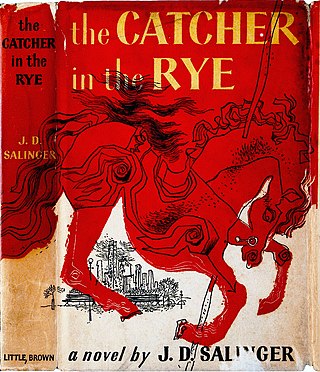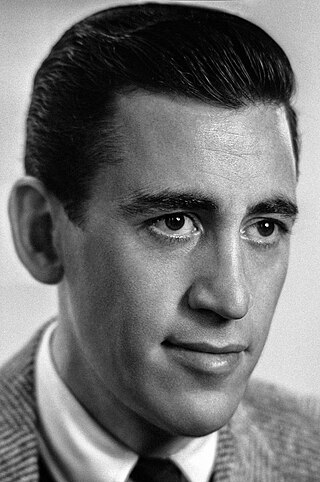Related Research Articles

The Catcher in the Rye is an American novel by J. D. Salinger that was partially published in serial form 1945–46 before being novelized in 1951. Originally intended for adults, it is often read by adolescents for its themes of angst and alienation, and as a critique of superficiality in society. The novel also deals with complex issues of innocence, identity, belonging, loss, connection, sex, and depression. The main character, Holden Caulfield, has become an icon for teenage rebellion. Caulfield, nearly of age, gives his opinion on a wide variety of topics as he narrates his recent life events.

Holden Caulfield is a fictional character in the works of author J. D. Salinger. He is most famous for his appearance as the lead character and narrator of the 1951 novel The Catcher in the Rye. Since the book's publication, Holden has become an icon for teenage rebellion and angst, and is considered among the most important characters of 20th-century American literature. The name Holden Caulfield was initially used in an unpublished short story written in 1941 and first appeared in print in 1945.
"A Perfect Day for Bananafish" is a short story by J. D. Salinger, originally published in the January 31, 1948, issue of The New Yorker. It was anthologized in 1949's 55 Short Stories from the New Yorker, as well as in Salinger's 1953 collection Nine Stories. The story is an enigmatic examination of a young married couple, Muriel and Seymour Glass, on vacation in Florida. It is the first of his stories to feature a member of the fictional Glass family.
"The Ocean Full of Bowling Balls" is an unpublished work by J. D. Salinger. It is about the death of Kenneth Caulfield, who later became the character Allie in The Catcher in the Rye.
"I'm Crazy" is a short story written by J. D. Salinger for the December 22, 1945 issue of Collier's magazine. Despite the story's underlying melancholy, the magazine described it as "the heart-warming story of a kid whose only fault lay in understanding people so well that most of them were baffled by him and only a very few would believe in him".
“A Boy in France” is an uncollected work of short fiction by J. D. Salinger which appeared in the 31 March, 1945 issue of The Saturday Evening Post.
"The Hang of It" is a short story by J. D. Salinger, first published in the July 12, 1941 issue of Collier's magazine.
“The Heart of a Broken Story” is a work of short fiction by J. D. Salinger published in the September 1941 issue of Esquire.
“Personal Notes of an Infantryman” is an uncollected work of short fiction by J. D. Salinger which appeared in the 12 September, 1942 issue of Collier's.
“The Varioni Brothers” is an uncollected work of short fiction by J. D. Salinger which appeared in the 17 July, 1943 issue of The Saturday Evening Post.
“Soft-Boiled Sergeant” is an uncollected work of short fiction by J. D. Salinger which appeared in the 26 February, 1944 issue of The Saturday Evening Post.
"Last Day of the Last Furlough" is a short story written by American writer J. D. Salinger in 1944 and published in the July 15th issue of Saturday Evening Post. It covers the last days of furlough for Babe Gladwaller before he is shipped off to World War II.
"This Sandwich Has No Mayonnaise" is an uncollected work of short fiction by J. D. Salinger which appeared in the October 1945 issue of Esquire. The story was published in the 1958 anthology The Armchair Esquire, edited by Arnold Gingrich and L. Rust Hills.

Jerome David Salinger was an American author best known for his 1951 novel The Catcher in the Rye. Salinger published several short stories in Story magazine in 1940, before serving in World War II. In 1948, his critically acclaimed story "A Perfect Day for Bananafish" appeared in The New Yorker, which published much of his later work.
“A Girl I Knew” is an uncollected work of short fiction by J. D. Salinger which appeared in the February 1948 issue of Good Housekeeping.
"The Last and Best of the Peter Pans" is an unpublished short story by J. D. Salinger.

Eli Waldron was an American writer and journalist whose primary work consisted of short stories, essays, and poetry. His writings were published in literary journals and popular periodicals. From the 1950s to 1970s he contributed stories and essays to The New Yorker, and in the 1960s and 1970s, a number of his poems and experimental fiction works appeared in underground, alternative, and "counter-culture" publications, such as The Illustrated Paper, Rat Subterranean News, Underground, The Village Voice, and The Woodstock Times.
Whit Burnett was an American writer and educator who founded and edited the literary magazine Story. In the 1940s, Story was an important magazine in that it published the first or early works of many writers who went on to become major authors. Not only did Burnett prove to be a valuable literary birddog for new talent, but Story remained a respectable though low-paying alternative for stories rejected by the large-circulation slick magazines published on glossy paper like Collier's or The Saturday Evening Post or the somewhat more prestigious and literary slick magazines such as The New Yorker. While Story paid poorly compared to the slicks and even the pulps and successor digest-sized magazines of its day, it paid better than most of, and had similar cachet to, the university-based and the other independent "little magazines" of its era.
E. Michael Mitchell was a Canadian-born artist reputed to be one of the few close friends of author J.D. Salinger and designer of the dust jacket for the first edition of Salinger's 1951 novel, Catcher in the Rye.

Neither Salinger in his lifetime nor his estate after his death has ever authorized publication of a volume of Salinger's registered early short fiction which appeared in magazines between 1940 and 1965. Reprints of his early stories have appeared under the auspices of Esquire and The New Yorker, to which Salinger stories had originally been sold.
References
- ↑ Salinger, J. D. (1 December 1945). "The Stranger". Collier's Weekly. New York: Crowell-Collier Publishing Company.
- ↑ Fiene, R. M. (Spring 1963). "J. D. Salinger: A Bibliography". Wisconsin Studies in Contemporary Literature. 4: 109–149.
- ↑ Weber, Myles (Spring 2001). "J. D. Salinger Partly Seen". The Sewanee Review. 110 (2): 52–54.